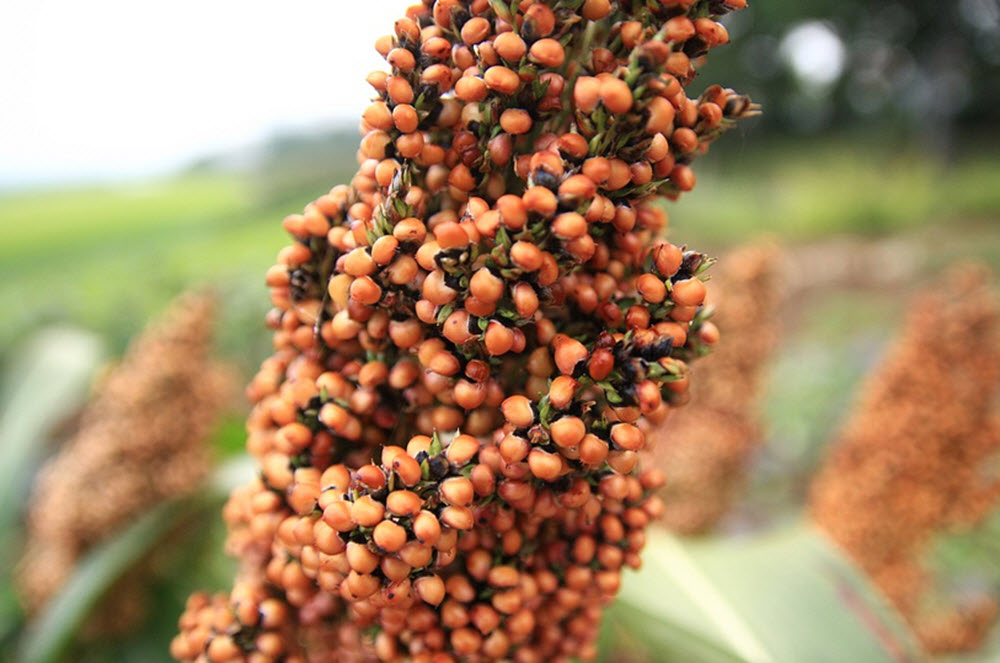Contents
Sorghum is a genus of roughly two dozen grass species and some of them are grown as cereals for human and livestock consumption. The most famous member of this genus Sorghum bicolor, which was originally domesticated in Africa is has become an important food crop in many parts of the tropical and subtropical world.
In addition to human and animal consumption, sorghum is also farmed to make bio-based ethanol.

Scientific classification of Sorghum bicolor
| Kingdom: | Plantae |
| Order: | Poales |
| Family: | Poaceae |
| Subfamily: | Panicoideae |
| Genus: | Sorghum |
| Species: | S. bicolor |
Sorghum bicolor production
Sorghum bicolor is the 5th most produced cereal food crop, outpaced by rice, wheat, maize and barley. It is known under several different common names, including great millet, milo, jowar, jowari and durra.
In 2018, nearly 60 million metric tons of sorghum bicolor was produced worldwide. By area, 90% of the sorghum fields are found in developing countries (especially in Africa and Asia), but the United States is the main producer by yield.
For the 2019/2020 crop, the United States was the main producer of sorghum, with a yield of nearly 9.5 million metric tons. That same period, Nigeria – the world´s second-largest sorghum producer – made 6.57 million metric tons. Other notable producers of sorghum bicolor are Ethiopia, Mexico, India and China. In recent years, the U.S. production of sorghum has declined, from a peak of 15.16 million metric tons for the 2015/2016 crop.
Globally, China has become an important driver of sorghum demand, as they began importing sorghum in 2013 to replace domestically grown corn as livestock feed. Currently, over 80% of the sorghum imported to China is used to feed livestock. It should be noted that China´s import of sorghum reached a peak in 2013-2015 and then declined somewhat.
Sorghum bicolor cultivation
Sorghum bicolor is farmed in tropical and subtropical parts of the world. It is typically grown as an annual, but some cultivars of this species can be grown as perennials.
Many different cultivars are available, including sweet sorghum cultivars which have a higher sugar content and are grown to make syrup or ethanol, or for foraging. These cultivars tend to be taller than the average sorghum bicolor.
Sorghum can be grown in a similar way to corn, and it is even possible for a farmer to use commercial corn planters to plant sorghum. Sorghum is typically planted at a depth of 2-5 cm.

Growing conditions
Sorghum bicolor is usually planted 50,000 to 300,000 seeds per hectare, depending on local conditions such as soil fertility and the need for row spacing. Sorghum is often planted in narrow rows, to take advantage of its ability to outcompete weeds. The roots release a chemical called sorgoleone that inhabits the growth of plants around it.
Sorghum bicolor not only survives but thrives when the daytime temperature exceeds 30 degrees C, making it an ideal crop for parts of the tropics where other cereals struggle to handle the daytime heat. For maximum yield, the average temperature should be at least 25 degrees C. This plant does not like the cold, and if the temperature drops below 13 degrees C it will be negative for the yield – especially if the plant is subjected to several cool nights in a row.
Sorghum bicolor is famous for being a very resilient cereal crop, with a great capacity for handling issues such as water scarcity and toxicity in the soil.
Sorghum bicolor and water-scarcity
- The sorghum bicolor leaves are protected by a waxy substance that limits water loss through evaporation.
- In times of drought, the leaves will roll up to lessen the water loss even more.
- Sorghum bicolor carry out C4 carbon fixation instead of C3 carbon fixation, and the C4 process uses just 1/3 the amount of water necessary for C3.
- Sorghum bicolor has a very large root-to-leaf surface area ratio.
- During droughts, the plant will go dormant instead of dying. It can remain dormant for a surprisingly long time during adverse conditions. When the water returns, sorghum bicolor plants are known for their great capacity for recovering growth.
- Sorghum bicolor has a short growing season, so it can yield a crop even if water is only available during a short part of the year.

